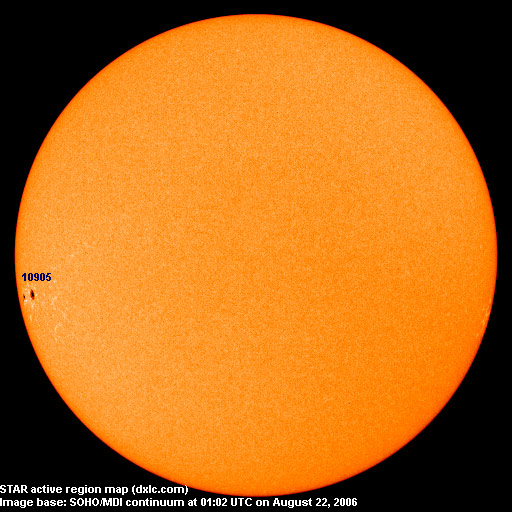

Last major update issued on August 22, 2006 at 04:10 UTC.
[Solar and
geomagnetic data - last month (updated daily)]
[Solar wind and
electron fluence charts (updated daily)]
[Solar cycles 21-23
(last update August 6, 2006)]
[Solar cycles 1-20]
[Graphical comparison
of cycles 21, 22 and 23 (last update August 6, 2006)]
[Graphical
comparison of cycles 2, 10, 13, 17, 20 and 23 (last update August 6, 2006)]
[Historical solar and
geomagnetic data charts 1954-2005 (last update March 3, 2006)]
[Archived reports (last update
August 6, 2006)]
The geomagnetic field was quiet to active on August 21. Solar wind speed ranged between 347 and 516 km/s (all day average 412 km/s - decreasing 2 km/s from the previous day). A high speed stream from CH236 began to dominate the solar wind after 15h UTC.
Solar flux measured at 20h UTC on 2.8 GHz was 87.8. The planetary A index
was 13 (STAR Ap - based on the mean of three hour interval ap
indices: 13.1).
Three hour interval K indices: 24222334 (planetary), 24323233 (Boulder).
The background x-ray flux is at the class B1 level.
At midnight there was 1 spotted region on the visible solar disk. The solar flare activity level was low. A total of 7 C class events was recorded during the day.
Region 10904 rotated out of view.
Flare: C4.7 at 19:23 UTC.
New region 10905 rotated fully into view at the southeast limb.
Flares: C3.6 at 00:50, C3.8 at 02:26, C3.0 at 04:49, C1.0 at 10:06,
C2.6 at 12:19 and C1.0 at 15:54 UTC.
August 19-21: No partly or fully Earth directed CMEs were detected in LASCO imagery.
Coronal hole history (since late October 2002)
Compare today's report to the situation one solar rotation ago:
28 days ago
27 days ago
26 days ago
A coronal hole (CH236) in the southern hemisphere rotated across the central meridian on August 18.

Processed SOHO/EIT 284 image at 19:08 UTC on August 18. The darkest areas on the solar disk are likely coronal holes.
The geomagnetic field is expected to be quiet to active on August 22 and quiet to unsettled on August 23-24.
| Coronal holes (1) | Coronal mass ejections (2) | M and X class flares (3) |
1) Effects from a coronal hole could reach Earth
within the next 5 days. When the high speed stream has arrived the color changes to green.
2) Effects from a CME are likely to be observed at Earth within 96 hours.
3) There is a possibility of either M or X class flares within the next 48 hours.
Green: 0-20% probability, Yellow: 20-60% probability, Red: 60-100% probability.
Long distance low and medium frequency (below 2 MHz) propagation along east-west paths over high and upper middle latitudes is poor. 800 VOWR and 930 CJYQ were the only stations from North America audible near LSR. Several stations from Colombia had fairly good signals with the best being 1250 Capital Radio. Propagation on long distance northeast-southwest paths is fair to good with several stations from Argentina and Uruguay heard with fair to good signals.

Compare to the previous day's image.
Data for all numbered solar regions according to the Solar Region Summary provided by NOAA/SEC. Comments are my own, as is the STAR spot count (spots observed at or inside a few hours before midnight) and data for regions not numbered by SEC or where SEC has observed no spots. SEC active region numbers in the table below and in the active region map above are the historic SEC/USAF numbers.
| Active region | Date numbered | SEC spot count |
STAR spot count |
Location at midnight | Area | Classification | Comment |
|---|---|---|---|---|---|---|---|
| 10904 | 2006.08.09 | 1 | S12W88 | 0180 | HHX | rotated out of view | |
| 10905 | 2006.08.20 | 3 | 5 | S08E74 | 0100 | CAO | formerly region S672 classification was DAO at midnight |
| Total spot count: | 4 | 5 | |||||
| SSN: | 24 | 15 | |||||
| Month | Average solar flux at Earth |
International sunspot number | Smoothed sunspot number |
|---|---|---|---|
| 2000.04 | 184.2 | 125.5 | 120.8 cycle 23 sunspot max. |
| 2000.07 | 202.3 | 170.1 | 119.8 |
| 2001.12 | 235.1 | 132.2 | 114.6 (-0.9) |
| 2005.06 | 93.7 | 39.3 | 28.8 (-0.1) |
| 2005.07 | 96.4 | 40.1 | 29.1 (+0.3) |
| 2005.08 | 90.5 | 36.4 | 27.4 (-1.7) |
| 2005.09 | 91.1 | 21.9 | 25.8 (-1.6) |
| 2005.10 | 77.0 | 8.5 | 25.5 (-0.3) |
| 2005.11 | 86.3 | 18.0 | 24.9 (-0.6) |
| 2005.12 | 90.7 | 41.2 | 23.0 (-1.9) |
| 2006.01 | 83.4 | 15.4 | 20.8 (-2.2) |
| 2006.02 | 76.5 | 4.7 | (18.4 predicted, -2.4) |
| 2006.03 | 75.4 | 10.8 | (16.6 predicted, -1.8) |
| 2006.04 | 89.0 | 30.2 | (15.9 predicted, -0.7) |
| 2006.05 | 80.9 | 22.2 | (15.1 predicted, -0.8) |
| 2006.06 | 76.5 | 13.9 | (12.9 predicted, -2.2) |
| 2006.07 | 75.7 | 12.2 | (11.4 predicted, -1.5) |
| 2006.08 | 80.0 (1) | 14.3 (2) | (11.4 predicted, -0.0) |
1) Running average based on the
daily 20:00 UTC observed solar flux
value at 2800 MHz.
2) Unofficial, accumulated value based on the Boulder (NOAA/SEC)
sunspot number. The official international sunspot number is typically
30-50% lower.
This report has been prepared by Jan Alvestad. It is based partly on my own observations and analysis, and partly on data from some of these solar data sources. All time references are to the UTC day. Comments and suggestions are always welcome.
| [DX-Listeners' Club] |